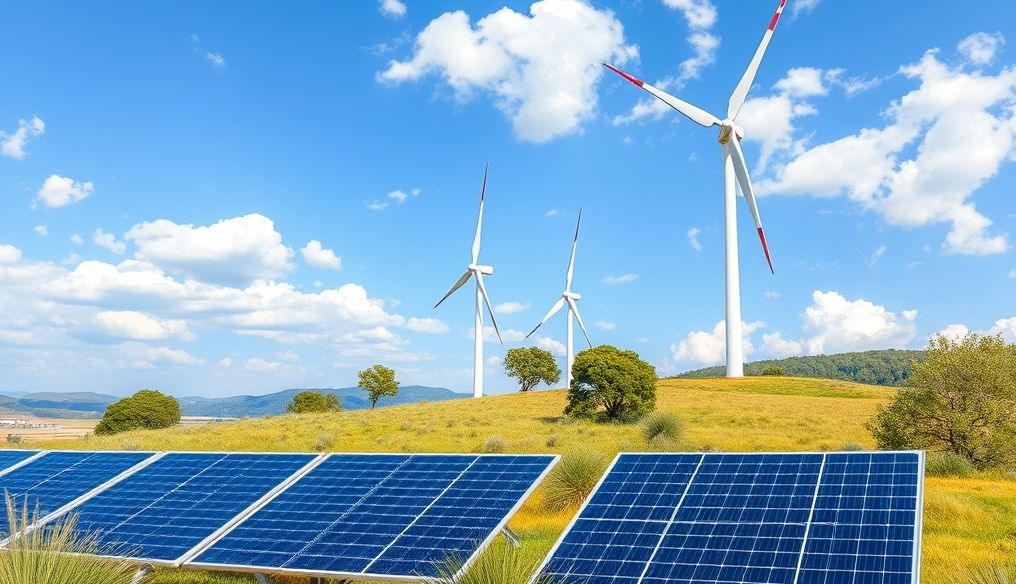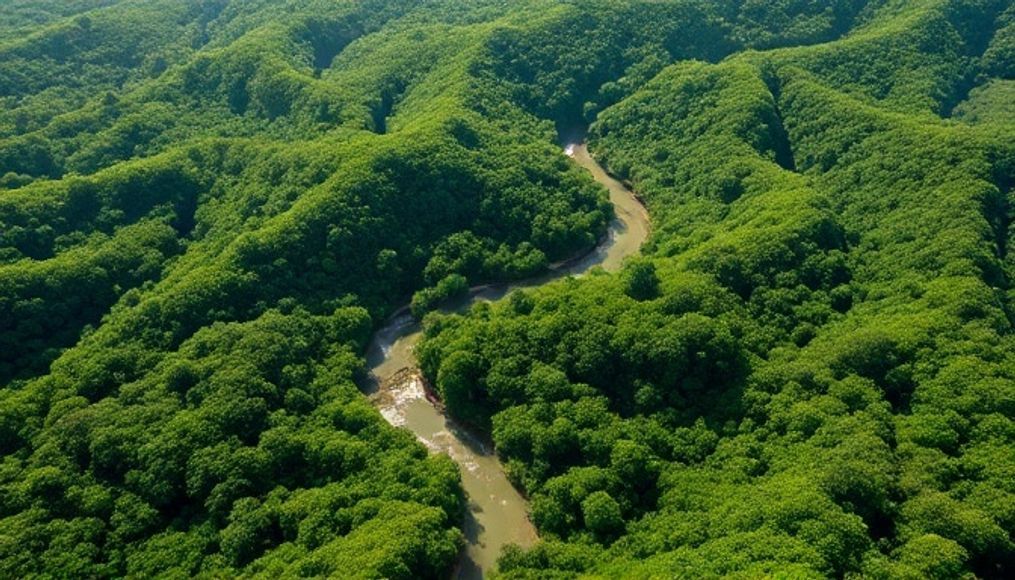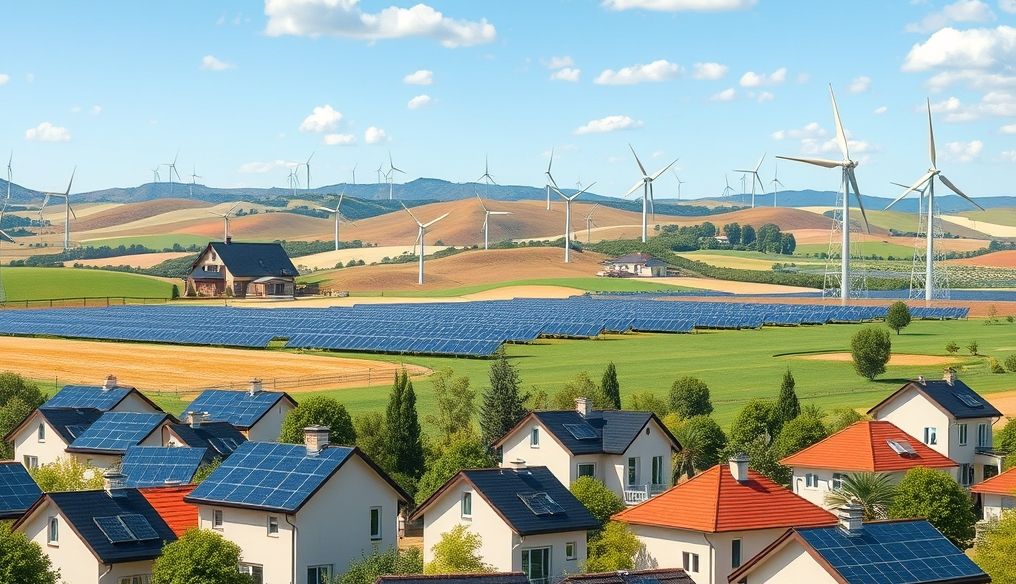What is Renewable Energy (Solar, Wind) and How Does it Work?
With growing concerns about climate change and the depletion of fossil fuel resources, renewable energy has emerged as a promising solution for meeting our energy needs in a sustainable way. Renewable energy includes various sources such as solar energy, wind energy, hydropower, geothermal energy, and biomass energy. In this article, we will focus specifically on solar and wind energy, which are among the most common and developed renewable energy sources.
What is Renewable Energy?
Renewable energy is energy derived from natural sources that are constantly replenished, such as sunlight, wind, water, and geothermal heat. Unlike fossil fuels, such as coal, oil, and natural gas, renewable energy sources are inexhaustible and do not contribute to greenhouse gas emissions that cause climate change.
Advantages of Renewable Energy:
- Reducing greenhouse gas emissions
- Reducing dependence on fossil fuels
- Creating new job opportunities in the clean energy sector
- Improving air quality and public health
- Providing sustainable energy for future generations
Solar Energy: Harnessing the Power of the Sun
Solar energy is energy derived from sunlight. Sunlight can be converted into electricity using various technologies, including photovoltaic cells and solar thermal power systems.
How do Photovoltaic Cells Work?
Photovoltaic (PV) cells are devices made of semiconductor materials, such as silicon, that convert sunlight directly into electricity. When sunlight strikes a PV cell, it causes electrons to be released from the atoms of the semiconductor material. These electrons are directed through an electrical circuit, producing an electric current that can be used to power devices and buildings.
Components of a Photovoltaic Solar System:
- Solar Panels: Consist of a collection of PV cells connected to each other.
- Inverter: Converts direct current (DC) generated by solar panels into alternating current (AC) that can be used in homes and buildings.
- Mounting System: Secures the solar panels to the roof or ground.
- Electricity Meter: Measures the amount of electricity produced and consumed.
- Batteries (Optional): Store excess electricity for use at night or on cloudy days.
Solar Thermal Power Systems
Solar thermal power systems use mirrors to concentrate sunlight on a receiver, which heats a fluid such as oil or water. This hot fluid is used to produce steam, which drives a turbine to generate electricity. These systems are often used in large power plants.
Types of Solar Thermal Power Systems:
- Parabolic Trough Systems: Use mirrors in the shape of parabolic troughs to concentrate sunlight on a tube running through the center of the trough.
- Central Receiver Systems: Use a collection of mirrors (heliostats) to concentrate sunlight on a receiver located at the top of a tower.
- Parabolic Dish Systems: Use mirrors in the shape of parabolic dishes to concentrate sunlight on a small heat engine located at the focus of the dish.
Wind Energy: Nature's Power Serving Humanity
Wind energy is energy derived from the movement of air. Wind energy is converted into electricity using wind turbines.
How do Wind Turbines Work?
Wind turbines are tall structures with blades that rotate when the wind blows. The blades are connected to an electrical generator that converts the kinetic energy of the wind into electricity. Wind turbines can be small, enough to power a single home, or large, enough to generate electricity for thousands of homes.
Components of a Wind Turbine:
- Blades: Rotate by the wind and connect to the hub.
- Hub: Transfers the rotational energy from the blades to the generator.
- Generator: Converts rotational energy into electricity.
- Tower: Supports the generator and blades at a high altitude to capture more wind.
- Gearbox: Increases the rotational speed of the shaft to match the generator speed. (In some designs)
- Control System: Monitors and controls the operation of the turbine.
Types of Wind Turbines
There are two main types of wind turbines:
- Horizontal-Axis Wind Turbines: Are the most common, and feature blades that rotate around a horizontal axis.
- Vertical-Axis Wind Turbines: Feature blades that rotate around a vertical axis. They are less efficient than horizontal-axis wind turbines, but they can operate in different wind directions without needing to change their orientation.
Challenges of Renewable Energy
Despite the many advantages of renewable energy, it faces some challenges:
- Intermittency: Solar and wind energy depend on weather conditions, which means they cannot provide constant power around the clock, seven days a week.
- Cost: The cost of installing renewable energy systems can be high initially, although costs have decreased significantly in recent years.
- Space: Solar and wind farms require large areas of land.
- Environmental Impact: Solar and wind farms can have an environmental impact on landscapes and wildlife.
The Future of Renewable Energy
Despite the challenges, the future of renewable energy looks promising. With continued technological advancements and declining costs, renewable energy is expected to play an increasingly important role in meeting our energy needs in the future. Renewable energy can help reduce greenhouse gas emissions, create new jobs, and provide sustainable energy for future generations.
The Role of Storage in the Future of Renewable Energy
Energy storage plays a crucial role in overcoming the intermittency challenge of renewable energy. Energy storage systems, such as batteries, can store excess energy produced during periods of sunshine or strong winds, and release it when needed, ensuring a constant supply of energy.
Government Policies and Support for Renewable Energy
Government policies play an important role in supporting the growth of renewable energy. Governments can provide tax incentives, subsidies, and low-interest loans to encourage companies and individuals to invest in renewable energy. Governments can also set renewable energy standards, which require utilities to generate a certain percentage of electricity from renewable sources.
Renewable Energy and Health
The transition to renewable energy has significant health benefits. It reduces air pollution from fossil fuel power plants, which reduces respiratory diseases and cardiovascular diseases. It also reduces exposure to toxic substances emitted from fossil fuel extraction and processing.
Renewable Energy and the Economy
Investing in renewable energy creates new job opportunities in the manufacturing, installation, and maintenance sectors. It also reduces dependence on fossil fuel imports, which improves economic security and reduces energy price volatility.
Conclusion
Renewable energy, especially solar and wind energy, offers a sustainable and promising solution to meet our energy needs. While there are challenges, technological advancements and supportive government policies are accelerating the adoption of these clean sources. By investing in renewable energy, we can protect the environment, improve public health, and promote economic growth.




